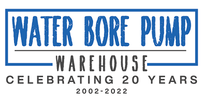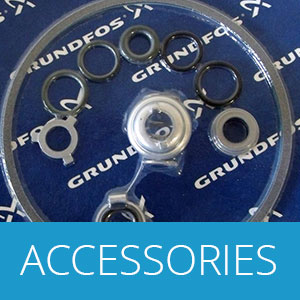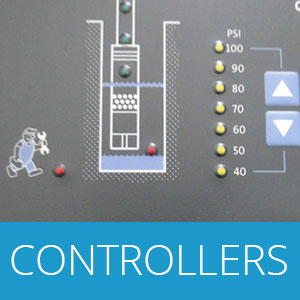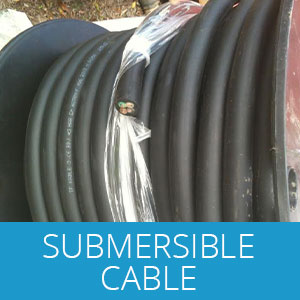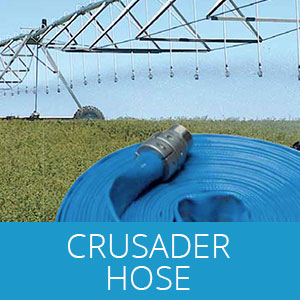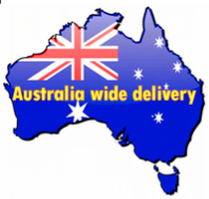Nobody knows more about bore pumps!
|
Water bore pumps are electrical components with a specially sealed motor attached to the pump body. The entire pump is underwater in the bore. Submersible pumps push water to the surface, whereas above-ground jet pumps have to pull the water from the borehole. Submersible water pumps are more efficient than jet pumps.
When selecting bore pumps for a particular application, you are influenced firstly by the characteristics of the water bore including casing diameter, total depth, screen length, standing water level, pumping water level, yield and water quality. The next consideration is what volume and pressure do you require the pump to deliver. Various programs can be used to calculate the total head and select the correctly sized pump. As a quick reference we add the depth of the pumping water level (which is a measurement in metres from ground level to the water level while the pump is running) to the height in metres of the tank above ground level at the top of the bore. If the pumping water level is 50 metres below ground level and the tank is 30 metres up the hill from the bore site the total head will be around 80 metres (excluding friction loss in pipes and valves). To run the pump as an automatic pressure system we allow around 45 metres head, excluding friction losses and variations in height. The Pump Curve Chart is an engineering calculation referring to the design performance and characteristics of the pump. Once you have calculated the total head and volume required the Pump Curve chart can be referenced to calculate the correctly sized pump.
We have over 20 years of experience in the selection, installation, fault finding and repairing submersible bore pumps, drilling and maintaining water bores. We are licensed Water Well Drillers with Mechanical and Electrical Trade qualifications. Try us - we can help you. |
Packaged pump kit ready for dispatch. Kit includes 4" submersible pump and drive motor, pump starter and submersible pump cable. All connections have been made and tested ready to install.
|

Bore pumps are usually used in a drilled opening into the ground to enable access to water contained in an aquifer. Water bores are drilled by a licensed water well driller to the standard set out in the Minimum Construction Requirements for Water Bores in Australia Edition 4 2020. A Permit is required to construct a water bore.
The drilled hole is cased with a minimum of 100mm PVC CL9 Bore Casing, and the production zone is screened with machine slotted 100mm CL12 PVC length of screen with a cap fitted to the bottom. The completed bore is air developed to clean the screen, allowing the maximum volume of water to enter before installing the bore pump.
Water bore depths, yield, standing water level, which is the level of the water below ground level, pumping water level, and expected use of the pumped water vary significantly from bore to bore, even in the same area.
Selecting bore pumps that suit these variables is imperative. An incorrectly specified pump will not work efficiently, causing failure in a short time.
The drilled hole is cased with a minimum of 100mm PVC CL9 Bore Casing, and the production zone is screened with machine slotted 100mm CL12 PVC length of screen with a cap fitted to the bottom. The completed bore is air developed to clean the screen, allowing the maximum volume of water to enter before installing the bore pump.
Water bore depths, yield, standing water level, which is the level of the water below ground level, pumping water level, and expected use of the pumped water vary significantly from bore to bore, even in the same area.
Selecting bore pumps that suit these variables is imperative. An incorrectly specified pump will not work efficiently, causing failure in a short time.
Bore Pumps from our shop
contact us about our bore pumps!

www.waterborepump.com.au
Reviewed by Trevor from WA on Aug 19.
From the first phone call to the final flow of water, these guys know what customer service is all about. When I decided to 'go it myself' I knew I was up for a challenge but what I didn't expect was having someone at the other end of the phone to help me the whole way. You went above and beyond Grant, thank you.
Rating: 5
Reviewed by Trevor from WA on Aug 19.
From the first phone call to the final flow of water, these guys know what customer service is all about. When I decided to 'go it myself' I knew I was up for a challenge but what I didn't expect was having someone at the other end of the phone to help me the whole way. You went above and beyond Grant, thank you.
Rating: 5
Understanding aquifers and drawdown
When an aquifer is accessed and tapped into by drilling a bore, the pressure of the water creates a water level known as the "standing water level" within the bore. This level rises and falls slightly with the seasons depending on what area you are in. An example of this is that in some parts of Australia, groundwater is replenished in wet seasons and dispersed into rivers and springs throughout the dry months. In the arid zone there may be very small amounts of movement of the groundwater level and the water could easily be thousands of years old.
When a water bore is pumped, the level of the water in the bore drops, which is called “drawdown”. Pumping water from a bore lowers it's pressure at inlets and water flows into them from the cracks and spaces in the underground chambers. The rate that water can be extracted from the water bore depends on the speed it can flow through the aquifer and it also depends on the available water level and drawdown.
If you over pump a water bore it may gradually deplete the natural resource and cause damage to the screen and failure of the pumping equipment. When water bores are drilled in close proximity to each other their target areas can compete. This can lead to each bore providing less water than it is designed to. If you have any questions with respect to your water bore and which bore pumps you should use, then please don't hesitate to give us a call on our 100% FREE ADVICE line 1300 727 042.
Water bore pumps are usually used in a water bore, which is a drilled opening into the ground to enable access to water contained in an aquifer. Water bores are drilled by a licensed water well driller to the standard set out in the Minimum Construction Requirements for Water Bores in Australia Edition 3 February 2012. A Permit is required to construct a water bore. In some areas a water meter is required to measure the amount of water taken from a water bore. Metering is usually only required on commercial water bores where an water allocation has been made. Stock and domestic water bores are not usually metered. Bore pumps are a device which is used to pump water from the water bore. The main components include the pump and motor unit, a submersible electrical cable, a pipe to connect the pump to the bore cap, which is required to hang the pump assembly on and to connect the below ground pipe to the above ground pipe, valves, and controls. The pump can be regulated, turned on and off to suit irrigation, tank filling and various other requirements by the pump control box, motor and pump protection, variable frequency drive and solar input can all be added to the pump control box. We specialize in providing replacement pumps, motors, controllers and accessories, right through to packaged pump kits for homes, irrigation, commercial uses, mine sites and remote areas.
